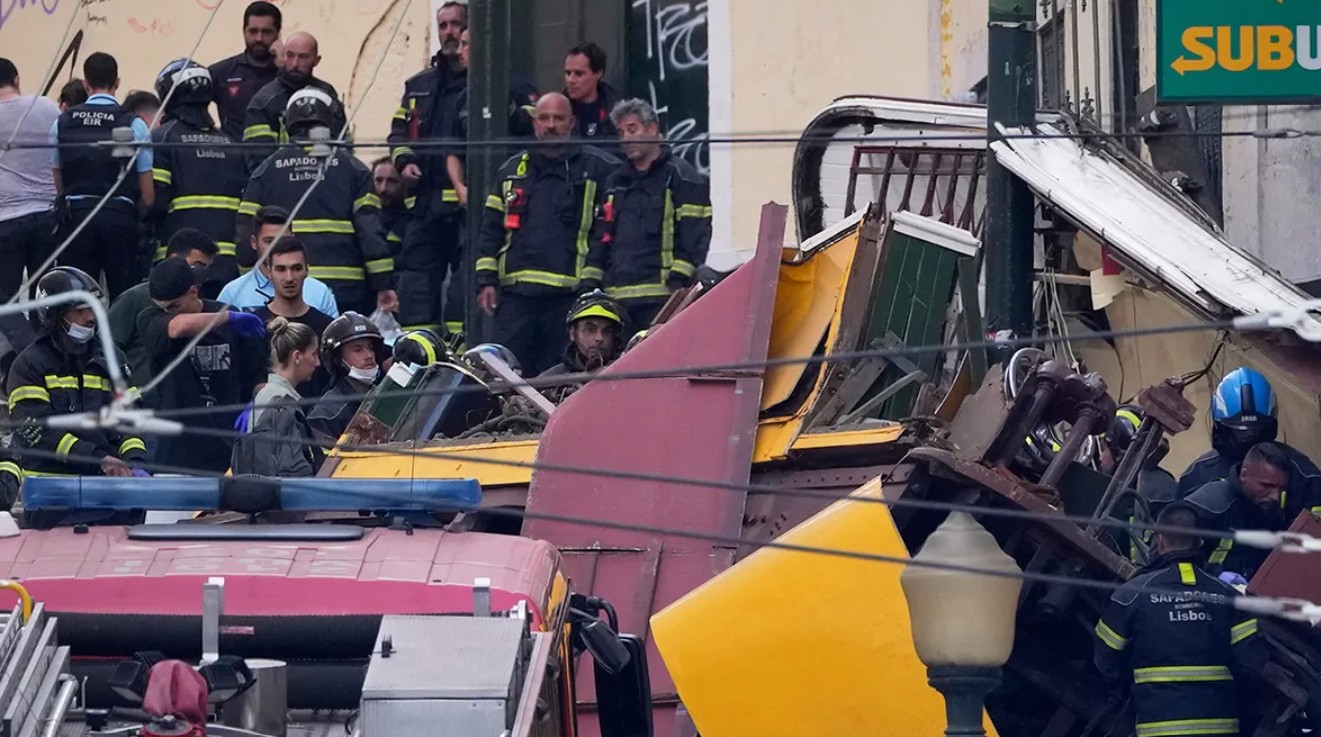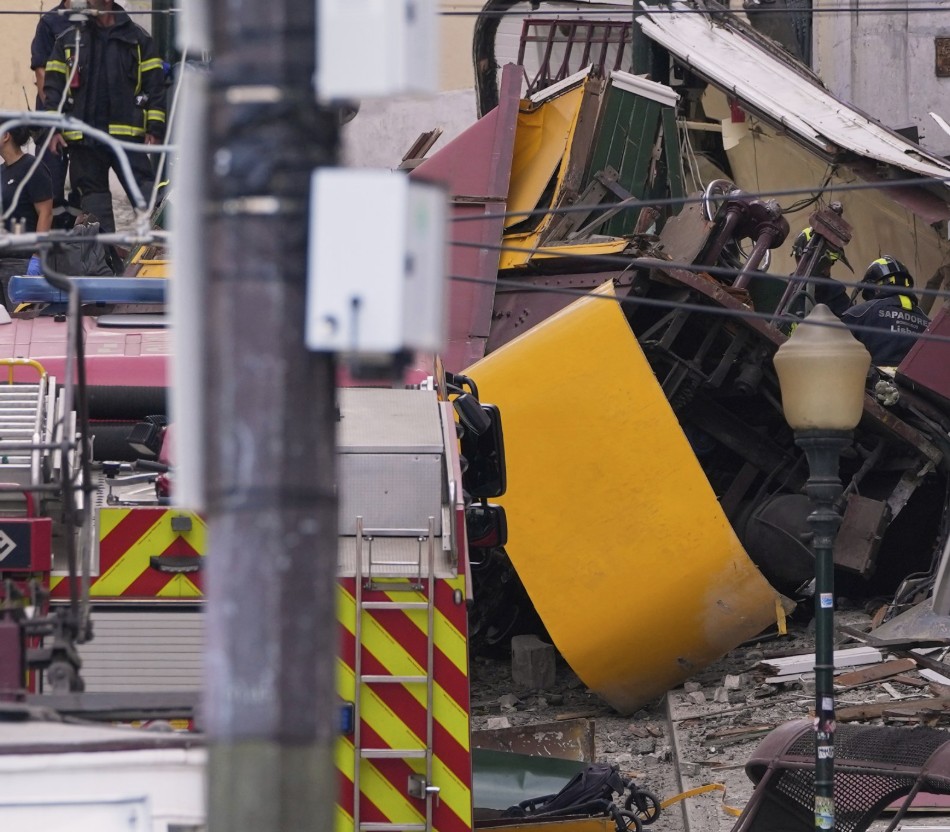On Wednesday evening, tragedy struck in Lisbon when one of the city’s most iconic transport systems, the historic Elevador da Glória funicular, derailed and crashed. According to reports from Portugal’s health ministry, the accident left at least 15 people dead and 18 others injured, five of them in critical condition.

For Lisbon, a city that blends history, culture, and tourism in almost every corner, the event was more than just an accident it was a devastating blow to its identity. The Elevador da Glória was not just a means of transport but a beloved cultural landmark that had carried millions of passengers over its long history. The crash has left residents mourning, officials scrambling for answers, and the world watching in shock.
The Details of the Crash and Video
The incident occurred shortly after 6 PM local time on Wednesday. According to the Lisbon Firefighters Regiment, the tragedy was caused when a cable reportedly snapped, sending the funicular car hurtling out of control before it slammed into a nearby building.
The violent derailment caused devastation both inside and outside the tram. Passengers who had been enjoying the short yet scenic ride from Restauradores Square up to the Bairro Alto neighborhood were caught completely off guard. Pedestrians walking along the steep street were also caught in the chaos, making them part of the casualty count.
Emergency services responded rapidly. Images from the site showed firefighters and medics rushing to extract victims from the overturned yellow tram, one of Lisbon’s most photographed symbols. Police cordoned off the area as rescue operations stretched into the evening.
The Cultural and Historical Significance of the Elevador da Glória
The Elevador da Glória is more than just a cable railway. Built in 1885, it has been part of Lisbon’s daily life for over a century. Its purpose was practical: to help residents navigate the city’s famously steep hills. But over time, it transformed into a symbol of Lisbon’s charm and resilience.

The funicular connects the busy Restauradores Square, located near the downtown Baixa district, to the picturesque Bairro Alto, one of the city’s liveliest neighborhoods. The short but steep ride offered visitors stunning views of Lisbon’s historic quarters, making it a must-do attraction for tourists.
The two-car system, operated by Carris, Lisbon’s public transport operator, could carry up to 42 passengers per tram. While many locals today opt for modern transport, the funicular has remained deeply embedded in Lisbon’s identity. It represents a bridge between the city’s historic heritage and its present-day vibrancy. For tourists, riding the Elevador da Glória was an experience that combined nostalgia with adventure.
That such an iconic landmark should end in disaster has magnified the grief. The accident is not only a human tragedy but also a cultural one.
The Victims and the Injured
In the aftermath, authorities quickly confirmed that the victims included both Portuguese citizens and foreign tourists. Tiago Augusto, head of Portugal’s health ministry, stated that nationalities were still being verified but reassured that no children were among the deceased.
By 8:30 PM local time, all the injured had been transported to hospitals across Lisbon. Six individuals, including one child and one person with particularly serious injuries, were taken to Santa Maria Hospital. Another nine victims, five of whom were in critical condition, were admitted to São José Hospital.
Witnesses described scenes of confusion and horror, with survivors calling for help as emergency teams tried to free those trapped in the wreckage. For many, what began as a joyful sightseeing trip turned into a nightmare. Families of the victims were left in shock, awaiting confirmation of their loved ones’ conditions.
Official Reactions and Public Mourning
The tragedy prompted immediate responses from Lisbon’s leadership. Mayor Carlos Moedas expressed his deep sorrow in a statement posted to social media. Calling it a “tragic moment” for Lisbon, he wrote:
“Lisbon is in mourning. This is a tragic moment for the city. The teams from CML – Firefighters Sappers Regiment, Civil Protection and Municipal Police – as well as the Volunteer Firefighters, the PSP, and the INEM, are on the scene providing assistance. The victims have been taken to the hospital. I deeply regret the lives lost and all the suffering caused. At this moment, what matters is to act: support the families, assist the injured, and ensure all necessary support to the authorities on the ground.”
In a separate post, he announced that the Lisbon City Council would decree three days of Municipal Mourning. Flags across public buildings were lowered to half-mast, and cultural events scheduled for the coming days were either canceled or postponed.
The mayor’s words reflected the mood of the city: a mixture of grief, disbelief, and a strong sense of solidarity with those affected. Residents gathered near the site, leaving flowers and candles in tribute. For Lisbon, this was not merely an accident it was an event that cut deeply into the collective heart of the community.
Broader Context and Implications
Beyond the immediate sorrow and shock, the crash has raised urgent questions about infrastructure safety in Lisbon. The Elevador da Glória is more than 130 years old. While it has undergone maintenance and modernization over the decades, the disaster highlights the challenges of operating aging transport systems in modern cities.
Investigators will likely scrutinize whether the snapped cable was due to technical failure, insufficient maintenance, or systemic oversight. The tragedy could lead to stricter regulations, increased inspections, and potential upgrades for Lisbon’s other historic transport systems, including the Elevador de Santa Justa and other funiculars like Lavra and Bica.
For Lisbon’s tourism sector, the accident may also have lasting consequences. The Elevador da Glória was a staple of guidebooks and travel blogs. Tourists who flocked to Lisbon for its blend of history and charm may now reconsider such attractions, fearing safety risks. Ensuring that the city can rebuild trust in its historic transport systems will be essential.
Human Stories Amid the Tragedy
Though officials have not yet released the names of the deceased, reports suggest that both Portuguese citizens and foreigners were among the victims. Some had been tourists capturing photographs of Lisbon’s iconic tram, while others were pedestrians simply walking by. The randomness of the tragedy has left many shaken: anyone could have been in that spot at that moment.
For survivors, the road ahead will be long. Many are grappling not only with physical injuries but also with emotional scars. Witnesses have recounted hearing screams, the sound of the cable snapping, and the violent crash that followed. These memories are likely to linger far beyond the physical recovery.
The Lisbon funicular crash is a tragedy that has touched the city at multiple levels human, cultural, and symbolic. At least 15 lives lost and 18 more injured mark a devastating toll. For Lisbon, the accident represents not only the fragility of life but also the vulnerability of its cherished landmarks.
The Elevador da Glória, once a source of pride and nostalgia, now carries the memory of loss. As emergency teams and investigators continue their work, the city has come together in mourning. From the mayor’s declaration of three days of municipal mourning to the outpouring of grief from residents and tourists alike, Lisbon stands united in sorrow.
Yet out of this tragedy may come lessons. The need for stringent safety checks, greater attention to aging infrastructure, and a renewed commitment to protecting lives while preserving heritage has never been clearer.
Lisbon will heal, but the memory of this tragic evening will remain. The challenge ahead lies not only in preventing another such disaster but also in honoring the victims by ensuring that the city’s beloved landmarks remain safe symbols of its history and soul.
News –